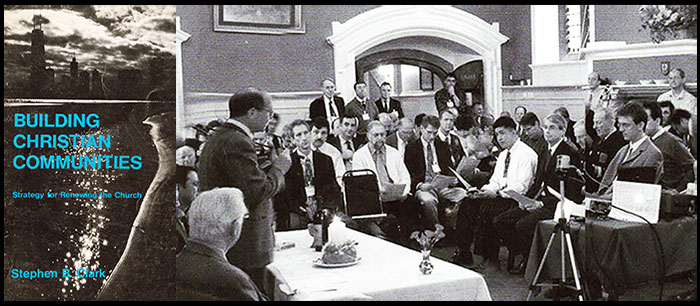Vital Christian communities are formed only through centering on Christ (through spiritual renewal).
Introduction by Bruce Yocum
The following article is adapted from Steve Clark’s book, Building Christian Communities, Chapter 4.
Steve Clark’s 1972 book Building Christian Communities: Strategy for Renewing the Church was the first systematic exposition of the principles behind the vision that covenant communities came to embody. In it, he describes the importance of environment for forming individuals and argues that since the larger modern social environment is not conducive to Christian living, environments must be constructed to counteract its influence. What the Church needs, he argues, is “basic Christian community.” He defines it as follows:
A basic Christian community is an environment of Christians which can provide for the basic needs of members to live the Christian life. As such it is the smallest self-sustaining unit of Christian living. In it, its members can find on a regular basis all they need for living the Christian life.
Steve Clark’s book is not specifically aimed at the charismatic renewal. In fact, the book was written for the Cursillo movement and draws on the experience of efforts at Catholic Church renewal in Latin America, as well as the call of the Latin American Catholic bishops for basic Christian community in the documents of their conference in Medellín, Colombia, in 1969. It does, however, also draw on the experience and example of the emerging community in Ann Arbor. Clark also mentions charismatic renewal as one of the movements that he sees as resources for building community.
A Christian community, he says, is a special kind of environment. First, it must consist of people who have a personal commitment to Christ. As an environment, it must be “relationship-oriented and not just task-oriented.” It must also be a large enough group to provide what is needed by its members, and in a small enough geographical area that relationships can be maintained. In addition to these characteristics, it must have organization and unity, and be concerned with “all that is involved in being a Christian.”
The Vitality of a community
When a community has vitality, it can do a great deal. For one thing, it is very active. Often, we contrast a dead parish with one that is alive. The difference between the two lies in the fact that a parish which is alive has a great deal of activity connected with it. But there are other signs of vitality than activity. Growth is one. A community which is alive, grows. People want to get “where the action is.” Another sign of vitality is the effectiveness of activities. When a community or movement or organization is alive, it has an effect on its surroundings and a great impact on the lives of the people who make it up. In one Mexican village, the Catholic Church has many more activities going on than the Communist Party. Yet the Communist Party is running the town and the members of the Communist Party are noted for being more dedicated men. The Communist Party has a much greater vitality in that village.
A community has vitality when it has more resources going into its life and when those resources are well used. A community begins to come alive when its members put a great deal of their time, energy and money into it. When they do not, it is dead. Many Catholic parishes get only a minimal contribution from most of the parishioners. They come one hour a week, give a dollar or two a week, and hardly expend a thought or a concern on the life of the parish. Their lives are little affected by the fact that they belong to the parish, and the life of the parish is little strengthened by their membership. This is why, groups like the Jehovah’s Witnesses and the Mormons, even though they are much smaller than the Catholic Church, are much more alive.
When a community is weak or dying, every problem within the community seems insoluble. That is because there is not enough strength, not enough resources in the community to work on the problems. Even if there is enough understanding, problems are still insoluble. But, if a community is strong and alive, there does not seem to be any problem which is not a source of greater growth and strength and which cannot be handled. It is just like the human person. If someone is weak and run-down, he cannot handle a disease when he is hit. People with less vitality die more quickly. But if he is strong and healthy, he can come through the disease when he is hit. People with less vitality die more quickly. But if he is strong and healthy, he can come through the disease or injury with much more ease.
Spiritual renewal in the life of Christian churches
Many of the problems facing the Christian churches seem insoluble, not because no solutions can be thought up for problems, but because of the overall lack of vitality and dedication in the churches. What is needed is not primarily better solutions, but a renewal in the life of the Christian church. The problem of the decline in vocations is a good example. Fewer and fewer people want to become priests. It may be true that better methods of recruiting or more desirable working conditions will be a help in this problem (specific solutions to the specific problem). But an even more fundamental cause is that Catholics are putting less and less of their lives in religion. It does not mean that much to them. The vocations’ problem is much more a problem of the whole life of the church and the dedication of its members than simply a special structural problem that can be worked out by a specific solution.
There are many factors which go into the vitality of a community. Having a good structure, for instance, is certainly one of these factors. A bad structure can inhibit life; while a good structure can make life possible. A community can have all the resources in the world available to it, and if it cannot use them well, they will not produce much life. An Australian bushman can be much stronger than a senile American. But if the American knows how to use tools better than the bushman, he will be able to be a lot more effective with the strength he has than the bushman will be. In the same way, a good structure to a community will allow the resources that are there to result in a great deal more vitality, while a bad structure may stifle it. Many promising young communities die because the leaders do not have the understanding to know how to deal with the structural readjustments that need to come with growth.
Vitality of common purpose and commitment
Although there are many factors which go into making a community vital, the most direct source of vitality is purpose and the commitment of the members to that purpose. If a community has a purpose that is clear and compelling, one that seems to be of real importance, and if its members are committed to that purpose and therefore put as many of their resources as possible into fostering that purpose, the community will be a vital community. If the community has no purpose, it will not last, no matter how well-structured it is.
The most stable social groupings we know are held together by a very compelling purpose – survival. Human beings instinctively feel the need to stay alive: to eat, to find shelter, to have protection. They instinctively realize that this happens only in social groupings, and so they have formed tribes, cities, nations. Such social groupings have had a strong hold on those who have been part of them, because they have known that they could not live unless they were a part of such societies.
There have been other foundations for strong communities in our experience. The Communist Party, for instance, has formed a strong worldwide community (a highly organized community). Its vitality and resilience has, in great part, come from the commitment on the part of its members to the proletarian revolution and to all that is involved in that ideal. The members of the Communist Party have been willing to make great sacrifices of personal interest in order to further the cause. Great causes have mobilized many strong social movements.
A strong, common purpose can result in very effective action. Lack of agreement or consensus can paralyze a group. A political party, for instance, can be much more effective if it has an issue – a strong cause that it can unite around. Dissension over its purposes and directions often is the direct cause of losing many elections. We can see the same things in the current renewal in the churches. Many organizations and movements which were strong before Vatican II, all of a sudden lost direction and therefore effectiveness as a result of the lack of consensus produced by the renewal. The Cursillo movement would be a good example. In Mexico, the Cursillo movement maintained a clear grasp of a unique purpose and a commitment to it, and it became a strong force in the life of the church in that country. In the United States, after the Vatican Council, every group with an idea made use of the Cursillo movement. And as a result, after a strong beginning, the movement lost direction and effectiveness. Recently, there seems to be a reversal of that trend and some renewal in the life of the Cursillo movement in the United States.
There is, of course, a difference between the kind of purpose a community has and the kind an institution or an organization has. An institution or an organization has a particular goal or set of goals. The goal may be to make some product or service available. An automotive company has the goal of selling cars. The telephone company has the goal of making telephone communication available. Or the goal may be to effect a change in society. The American Society for the Prevention of Cruelty to Animals has the goal of changing the attitudes of Americans toward animals. The people who work within institutions or organizations, whether members or employees, are organized to work together to reach the goals of their particular institutions. The more clearly their interaction together is directed toward reaching the goals of the institution, the stronger and more effective the institution will be. A defining characteristic of the social grouping, called an institution, is that the people in it work together (function in interdependence) either to produce something or effect some kind of change in the world.
A common ideal and way of life
A community has a different kind of purpose. Its members do not work together as a community to produce something or to effect a change in society. But in a real community (a group of people with unity), the members do have a common purpose in the sense of a common ideal. They all live for something. A community fosters something in its common ideal. The members of the community do not work together, as a community, to achieve a particular goal or set of goals. But the fact that the community holds the same ideal means that the members of the community strengthen in each other the commitment to a certain ideal of life, and this ideal forms the lives of each of the members. In other words, the members of the community do not work together (except to build up the community). But they do share a common ideal, and so their lives have a common effect.
The contrast between the peace movement and a peace organization in a particular city makes the difference between the purpose of a community and the purpose of an institution more concrete. The peace movement includes many more people than all the peace organizations put together in this particular city. People belong to the peace movement because of certain convictions. They accept certain values, have certain interests, and are trying to put their lives in the service of peace. They may come to certain lectures, take part in demonstrations, sign petitions. But people can do this and not belong to a peace organization. Peace is an ideal in their lives; it determines many of their actions. But unless they also join a peace organization, they do not work together with others for certain concrete goals like getting a change in a draft law. For a peace organization to exist, the concrete goals must be agreed upon. For the peace movement to exist, each person can have different goals he is working hard on. But there must be a common ideal that molds their common life and interaction.
There is, then, a difference between the kind of purpose which a community has and that which an organization or institution has. An organization has a common task toward which work of the members is directed. A community has an ideal of life – it fosters an ideal among its members. It is that ideal that draws them together. But even though the kind of purpose which a community has is different from the kind an organization has, it is no less important for a community to have an ideal than it is for an organization to have a task. In fact, it is more important that the purpose be kept clear and the commitment of the members be kept strong in a community than in an organization, because a person can often be an effectively functioning part of an organization without much of a commitment to the purpose just as long as he is paid. But the life and vitality of the community depend on the free acceptance of the members of the purpose of the community.
In the modern world, the one ideal which everyone can accept is material well-being. Therefore, it is this ideal around which society forms. Nothing is allowed which damages or works against the material well-being of society. A person can convince another person of a falsehood, but he cannot rob him of his material possessions without punishment. But, if a special community wants to exist within modern society, it must have an ideal of its own that is important enough to warrant people forming a special community within society. It takes some effort to form a special community in the kind of society we have. Therefore, an ideal is needed which can motivate people to such an effort.
Once we can see the importance of a purpose, an ideal of life, for any community in modern society, then it makes more sense that the Christian community will be vital only if it has a purpose, a reason for existence, and one that its members put a high degree of value on, one that they are committed to. That which is unique about Christianity, its reason for existence, has to be important enough to people that they would want to invest time in Christian communities, or Christian communities will have no vitality and eventually cease to exist.
This article © by Steve Clark is adapted from Building Christian Communities: Strategy for Renewing the Church, Chapter 3. from Steve Clark’s book, Building Christian Communities: Strategy for Renewing the Church, 1996 Edition. It was first published in 1972 by Ave Maria Press, Notre Dame, USA, and then republished in 1996 by Word of Joy Foundation, Inc., Quezon City, Philippines.
Top photo credits: Building Christian Communities book cover and Steve Clark addressing the International Sword of the Spirit Coordinators Meeting at a conference center near London, UK in May 2004 © The Sword of the Spirit
Steve Clark has been a founding leader, author, and teacher for the Catholic charismatic renewal since its inception in 1967. Steve is past president of the Sword of the Spirit, an international ecumenical association of charismatic covenant communities worldwide. He is the founder of the Servants of the Word, an ecumenical international missionary brotherhood of men living single for the Lord.
Steve Clark has authored a number of books, including Baptized in the Spirit and Spiritual Gifts, Finding New Life in the Spirit, Growing in Faith, and Knowing God’s Will, Building Christian Communities, Man and Woman in Christ, The Old Testament in Light of the New.
- See articles by Steve Clark in Living Bulwark Archives



